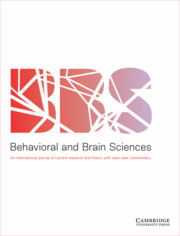Crossref Citations
This article has been cited by the following publications. This list is generated based on data provided by Crossref.
Chater, Nick
and
Oaksford, Mike
2013.
Programs as Causal Models: Speculations on Mental Programs and Mental Representation.
Cognitive Science,
Vol. 37,
Issue. 6,
p.
1171.
Frank, Michael C.
2013.
Throwing out the Bayesian baby with the optimal bathwater: Response to Endress (2013).
Cognition,
Vol. 128,
Issue. 3,
p.
417.
Oaksford, Mike
and
Chater, Nick
2014.
Probabilistic single function dual process theory and logic programming as approaches to non-monotonicity in human vs. artificial reasoning.
Thinking & Reasoning,
Vol. 20,
Issue. 2,
p.
269.
Piccinini, Gualtiero
and
Shagrir, Oron
2014.
Foundations of computational neuroscience.
Current Opinion in Neurobiology,
Vol. 25,
Issue. ,
p.
25.
Bonawitz, Elizabeth
Denison, Stephanie
Gopnik, Alison
and
Griffiths, Thomas L.
2014.
Win-Stay, Lose-Sample: A simple sequential algorithm for approximating Bayesian inference.
Cognitive Psychology,
Vol. 74,
Issue. ,
p.
35.
Stegmann, Ulrich E.
2015.
Prospects for Probabilistic Theories of Natural Information.
Erkenntnis,
Vol. 80,
Issue. 4,
p.
869.
Tentori, Katya
Chater, Nick
and
Crupi, Vincenzo
2016.
Judging the Probability of Hypotheses Versus the Impact of Evidence: Which Form of Inductive Inference Is More Accurate and Time‐Consistent?.
Cognitive Science,
Vol. 40,
Issue. 3,
p.
758.
Hall, Simon
Ali, Nilufa
Chater, Nick
Oaksford, Mike
and
Deng, Yong
2016.
Discounting and Augmentation in Causal Conditional Reasoning: Causal Models or Shallow Encoding?.
PLOS ONE,
Vol. 11,
Issue. 12,
p.
e0167741.
Zednik, Carlos
and
Jäkel, Frank
2016.
Bayesian reverse-engineering considered as a research strategy for cognitive science.
Synthese,
Vol. 193,
Issue. 12,
p.
3951.
Oaksford, Mike
and
Chater, Nick
2016.
Probabilities, causation, and logic programming in conditional reasoning: reply to Stenning and Van Lambalgen (2016).
Thinking & Reasoning,
Vol. 22,
Issue. 3,
p.
336.
Duffy, Sean
and
Smith, John
2017.
Category Effects on Stimulus Estimation: Shifting and Skewed Frequency Distributions - A Reexamination.
SSRN Electronic Journal ,
Duffy, Sean
and
Smith, John
2017.
On the Category Adjustment Model: Another Look at Huttenlocher, Hedges, and Vevea (2000).
SSRN Electronic Journal,
Duffy, Sean
and
Smith, John
2018.
Category effects on stimulus estimation: Shifting and skewed frequency distributions—A reexamination.
Psychonomic Bulletin & Review,
Vol. 25,
Issue. 5,
p.
1740.
Licato, John
and
Zhang, Zhitian
2019.
Evaluating representational systems in artificial intelligence.
Artificial Intelligence Review,
Vol. 52,
Issue. 2,
p.
1463.
Duffy, Sean
and
Smith, John
2020.
On the category adjustment model: another look at Huttenlocher, Hedges, and Vevea (2000).
Mind & Society,
Vol. 19,
Issue. 1,
p.
163.
Dupre, Gabe
2021.
Empiricism, syntax, and ontogeny.
Philosophical Psychology,
Vol. 34,
Issue. 7,
p.
1011.
Taylor, Samuel D.
and
Sutton, Peter R.
2021.
Concepts, Frames and Cascades in Semantics, Cognition and Ontology.
Vol. 7,
Issue. ,
p.
329.
Colombo, Matteo
Elkin, Lee
and
Hartmann, Stephan
2021.
Being Realist about Bayes, and the Predictive Processing Theory of Mind.
The British Journal for the Philosophy of Science,
Vol. 72,
Issue. 1,
p.
185.
Elliott, Edward
2022.
Comparativism and the Measurement of Partial Belief.
Erkenntnis,
Vol. 87,
Issue. 6,
p.
2843.
Nettle, Daniel
and
Scott-Phillips, Thom
2023.
Evolutionary Thinking Across Disciplines.
Vol. 478,
Issue. ,
p.
21.


Target article
The imaginary fundamentalists: The unshocking truth about Bayesian cognitive science
Related commentaries (1)
Bayesian Fundamentalism or Enlightenment? On the explanatory status and theoretical contributions of Bayesian models of cognition